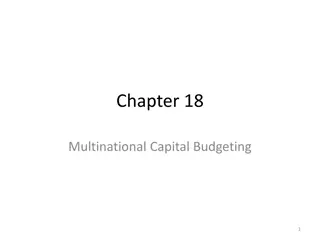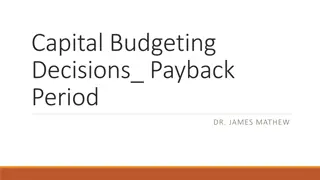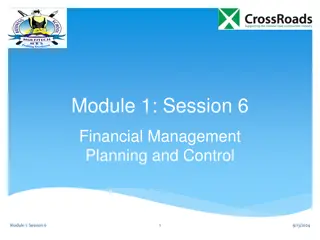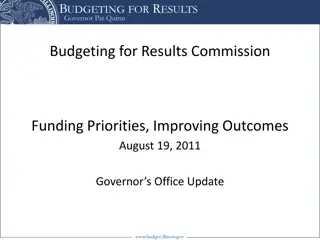
Understanding Capital Budgeting Process and Analysis Techniques
Explore the capital budgeting process involving project idea generation, proposal screening, evaluation methods like payback period and NPV, preparation of budgets, and post-completion audits. Learn about applying NPV analysis, estimating cash flows, and making decisions based on NPV calculations. Dive into concepts like mutually exclusive projects, multiple IRRs, and CCA acquisitions and disposals.
Uploaded on | 1 Views
Download Presentation

Please find below an Image/Link to download the presentation.
The content on the website is provided AS IS for your information and personal use only. It may not be sold, licensed, or shared on other websites without obtaining consent from the author. If you encounter any issues during the download, it is possible that the publisher has removed the file from their server.
You are allowed to download the files provided on this website for personal or commercial use, subject to the condition that they are used lawfully. All files are the property of their respective owners.
The content on the website is provided AS IS for your information and personal use only. It may not be sold, licensed, or shared on other websites without obtaining consent from the author.
E N D
Presentation Transcript
Capital Budgeting Process 1. Project idea generation 2. Screening of proposals 3. Project evaluation Payback period Discounted payback period Accounting rate of return (ARR) Internal rate of return (IRR) Net present value (NPV) Profitability index (PI) 4. Preparation of the capital budget 5. Monitoring and post-completion audits 2
Multiple IRRs Cash Flows (CAD) RRR (%) Difference (CAD) NPV (CAD) Year 0 Year 1 Year 2 0.0 -58.00 +149.00 % Change -94.00 % Change +55.00 -3.00 11.4 -58.00 +133.75 -10.23% -75.75 +19.41% +58.00 +0.00 26.2 -58.00 +118.07 -11.72% -59.02 +22.09% +59.05 +1.05 45.5 -58.00 +102.41 -13.26% -44.40 +24.77% +58.00 +0.00 50.0 -58.00 +99.33 -3.01% -41.78 +5.90% +57.56 -0.44 3
Mutually Exclusive Projects Year 0 1 2 3 4 Project 1 -CAD 220 Project 2 -CAD 220 100 80 80 60 30 70 110 130 Total Cash Inflows IRR CAD 320 CAD 340 18% 16% Project 1 NPV (CAD) Project 2 NPV (CAD) 120.00 RRR 0% 5% 6% 7% 8% 9% 10% 15% 20% 100.00 66.27 60.23 54.41 48.79 43.36 38.11 14.35 -5.88 74.04 65.93 58.15 50.67 43.48 36.56 5.67 -20.04 4
Applying NPV Analysis Types of Decisions Estimating Cash Flows Replacement Include relevant incremental after-tax cash flows Standalone Use opportunity cost Ignore sunk costs Incorporate side effects Consider qualitative factors Be cautious of overhead allocation Ignore financing costs Apply the correct discount rate 5
Applying NPV Analysis 1. Initial Cash Flows Cost of assets CCA tax shield on assets Increase or decrease in NWC 2. Recurring Cash Flows Incremental after-tax net cash flows 3. Terminal Cash Flows Disposal value of assets Loss of tax shield on disposal of assets Return of NWC to previous levels Decommissioning costs Rule: Accept all projects with a positive NPV 6
Applying NPV Analysis CCA Acquisitions and Disposals Sale of old asset Acquisition CCA rate CAD 7,000 CAD 31,000 20% UCC beginning Half of net acquisitions Balance CCA Year 1 UCC ending Half of net acquisition Balance CCA Year 2 UCC ending CAD 28,000 12,000 40,000 (8,000) CAD 32,000 12,000 44,000 (8,800) CAD 35,200 ??? ???? ??? ????+???) ( ? + ??? ? (?+???)) Present value of CCA tax shield = (Investment) (Marginal tax rate) ( 7
Incorporating Inflation Nominal Approach: Uses nominal dollar future cash flows and a nominal RRR Real Approach: Uses real dollar future cash flows and a real RRR Calculating the Nominal Rate Using the Fischer Effect Nominal rate = (1 + Real rate) x (1+ Inflation rate) 1 Nominal rate: 8.0% Inflation: 2.0% 0.08 = (1 + Real rate) x (1 + 0.02) 1.0 X =0.0588 or 5.88% 8






















